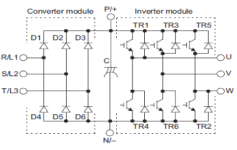I have a bit of an in-depth question on the operation of dynamic braking / regen. What I know and please correct anything that I am incorrect on...
Anytime the load is operating faster than the drive command, the motor will act as a generator causing a rise in the bus voltage. This is increase is dissipated by a resistor on the DC bus which is controlled by transistor (chopper).
An asynchronous motor will act as a generator when required capacitance is added to the stator and shaft speed is higher than rated motor RPM. The motor can also act as a generator when voltage is added to the stator to excite a field.
So when a VFD is running a motor at 60hz and is commanded to stop 0hz, how can the motor act as a generator when th shaft speed is obviously lower than the motors rated RPM. I’m guessing that through the drives transistors a field is still being generated in the stator allowing the motor to act as a generator. Is this correct?
Also how does the power flow backwards through the IGBTs to get back to the bus?
Anytime the load is operating faster than the drive command, the motor will act as a generator causing a rise in the bus voltage. This is increase is dissipated by a resistor on the DC bus which is controlled by transistor (chopper).
An asynchronous motor will act as a generator when required capacitance is added to the stator and shaft speed is higher than rated motor RPM. The motor can also act as a generator when voltage is added to the stator to excite a field.
So when a VFD is running a motor at 60hz and is commanded to stop 0hz, how can the motor act as a generator when th shaft speed is obviously lower than the motors rated RPM. I’m guessing that through the drives transistors a field is still being generated in the stator allowing the motor to act as a generator. Is this correct?
Also how does the power flow backwards through the IGBTs to get back to the bus?




